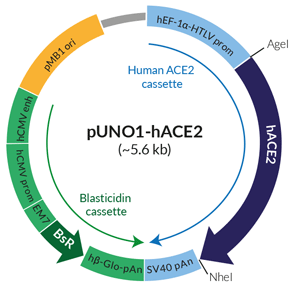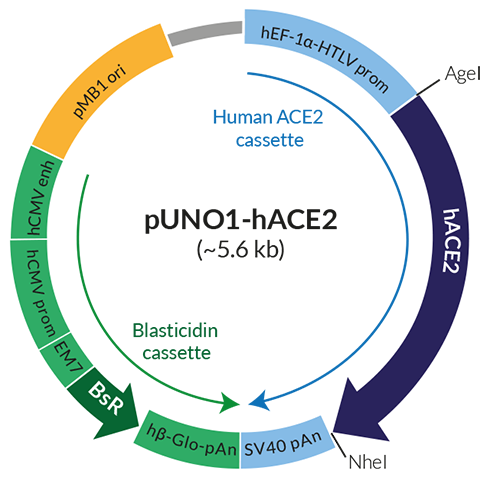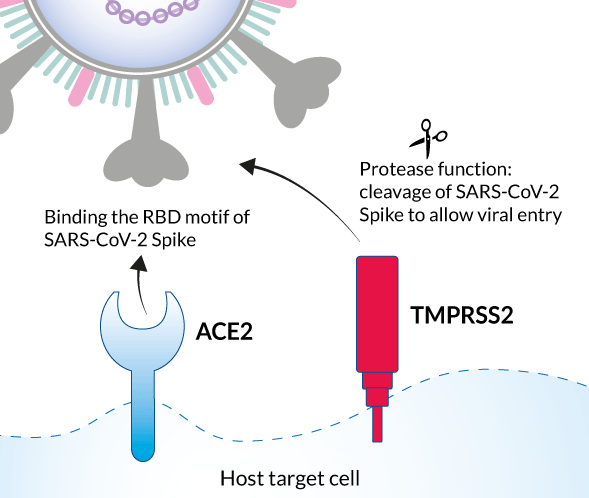Human ACE2 Expression Vector
| Product | Unit size | Cat. code | Docs. | Qty. | Price | |
|---|---|---|---|---|---|---|
|
pUNO1-hACE2 Human ACE2 gene |
Show product |
20 µg |
puno1-hace2
|
|
Human ACE2 coding sequence
GENE DESCRIPTION
Human ACE2 (angiotensin I-converting enzyme-2) is a type I surface transmembrane protein expressed in arteries, heart, kidneys, and epithelia of the lung and small intestine [1, 2]. ACE2 belongs to the angiotensin-converting enzyme family of dipeptidyl carboxydipeptidases [2, 3].
ACE2 also plays a critical role in the human pathogenesis of the coronavirus disease-19 (COVID-19) caused by the severe acute respiratory syndrome coronavirus-2 (SARS-CoV-2, or 2019-nCoV)). Indeed, hACE2 has been established as being the receptor for the Spike (S) protein of the SARS-CoV and SARS-CoV-2 coronaviruses, facilitating the viral entry into target cells [4-6] (See Details and Specifications for more information).

Schematic of human ACE2 expression vector
 InvivoGen also offers:
InvivoGen also offers:
• SARS-CoV-2-Cellular Receptor Genes
• SARS-CoV-2-Structural Genes
PLASMID DESCRIPTION
pUNO1-hACE2 features a potent mammalian expression cassette comprised of the ubiquitous human EF1α-HTLV composite promoter and the SV40 polyadenylation (pAn) signal. The ORF is flanked by unique restriction sites (AgeI and NheI) to facilitate its subcloning. The plasmid is selectable with blasticidin in both E. coli and mammalian cells. It can be used for transient or stable transfection. It contains no tag.
QUALITY CONTROL
- Fully sequenced ORF
- Predominant supercoiled conformation
hACE2 is also available together with hTMPRSS2a in the pDUO2-hACE2-TMPRSS2a plasmid.
If the blasticidin resistance gene does not fit your research purposes, hACE2 is also available in an expression vector selectable with puromycin (upon request).
![]() Read our reviews about SARS-CoV-2
Read our reviews about SARS-CoV-2
References
1. Harmer D. et al., 2002. Quantitative mRNA expression profiling of ACE2, a novel homolog of angiotensin-converting enzyme. FEBS Letters. 532(1-2):107-110.
2. Hamming I. et al., 2004. Tissue distribution of ACE2 protein, the functional receptor for SARS coronavirus. J. Pathol. 203:631-637.
3. Donoghue M. et al., 2000. A novel angiotensin-converting enzyme-related carboxypeptidase (ACE2) converts angiotensin I to angiotensin 1-9. Cir. Research. 87(5):e1-e9.
4. Li W. et al., 2003. Angiotensin-converting enzyme 2 is a functional receptor for the SARS coronavirus. Nature. 426(6965):450-454.
5. Hoffmann M. et al., 2020. SARS-CoV-2 cell entry depends on ACE2 and TMPRSS2 and is blocked by a clinically proven protease inhibitor. Cell. 181:1-16.
6. Zhou P. et al., 2020. A pneumonia outbreak associated with a new coronavirus of probable bat origin. Nature. 579(7798):270-273.
Specifications
- Alias: ACEH
- Specie: Human
- Genbank: NM_021804.3
- ORF size from ATG to Stop codon: 2418 bp
-
Subcloning restriction sites in pUNO1: AgeI (in 5’) and NheI (in 3’)
- AgeI generates cohesive ends compatible with XmaI, BspEI, NgoMIV, and SgrAI restriction sites
- NheI generates cohesive ends compatible with AvrII, SpeI, and XbaI restriction sites -
Sequencing primers:
- Forward HTLV 5’UTR: TGCTTGCTCAACTCTACGTC
- Reverse SV40 pAn: AACTTGTTTATTGCAGCTT
Contents
- 20 μg of lyophilized DNA
- 2 x 1 ml blasticidin at 10 mg/ml
![]() The product is shipped at room temperature.
The product is shipped at room temperature.
![]() Lyophilized DNA should be stored at -20°C.
Lyophilized DNA should be stored at -20°C.
![]() Resuspended DNA should be stored at -20°C and is stable up to 1 year.
Resuspended DNA should be stored at -20°C and is stable up to 1 year.
![]() Blasticidin is a harmful compound. Refer to the safety data sheet for handling instructions.
Blasticidin is a harmful compound. Refer to the safety data sheet for handling instructions.
Store blasticidin at 4°C or -20°C for up to two years. The product is stable for 2 weeks at 37°C.
Avoid repeated freeze-thaw cycles.
Back to the topDetails
ACE2 is a metalloproteinase that cleaves angiotensin I to angiotensin 1-9 and angiotensin II to form angiotensin 1-7, as well as other peptides unrelated to the angiotensin system [1, 2]. ACE2 is thought to be an essential regulator of cardiac function and blood pressure [1].
Human ACE2 has also been described as a receptor for the Spike (S) protein of the SARS-CoV and SARS-CoV-2 coronaviruses, facilitating the viral entry into target cells [3-6]. SARS-CoV and SARS-CoV-2 share most of the amino acid residues essential for ACE2 binding within their Spike receptor-binding domain (RBD) [5]. Of note, SARS-CoV-2 is able to use human, Chinese horseshoe bat, civet, and pig ACE2, but not murine ACE2, to enter cells [6].
SARS-CoV-2 entry into ACE2-expressing cells also depends on the concerted action of host proteases. While the exact timing and location for these processes to take place remain to be determined, it has been proposed that the S protein is cleaved into two subunits (S1 and S2) by proteases, including furin and TMPRSS2 [5, 7]. S1 binds to ACE2 and S2 is further cleaved and activated by the host surface-associated transmembrane protease serine 2 (TMPRSS2) [5, 7]. Together these actions result in host-viral membrane fusion and the viral RNA genome is released into the host cell cytoplasm.
Human ACE2 is currently investigated among therapeutic strategies to fight SARS-CoV and SARS-CoV-2 infections [8].
References
1. Donoghue M. et al., 2000. A novel angiotensin-converting enzyme-related carboxypeptidase (ACE2) converts angiotensin I to angiotensin 1-9. Cir. Research. 87(5):e1-e9.
2. Harmer D. et al., 2002. Quantitative mRNA expression profiling of ACE2, a novel homolog of angiotensin-converting enzyme. FEBS Letters. 532(1-2):107-110.
3. Hamming I. et al., 2004. Tissue distribution of ACE2 protein, the functional receptor for SARS coronavirus. J. Pathol. 203:631-637.
4. Li W. et al., 2003. Angiotensin-converting enzyme 2 is a functional receptor for the SARS coronavirus. Nature. 426(6965):450-454.
5. Hoffmann M. et al., 2020. SARS-CoV-2 cell entry depends on ACE2 and TMPRSS2 and is blocked by a clinically proven protease inhibitor. Cell. 181:1-16.
6. Zhou P. et al., 2020. A pneumonia outbreak associated with a new coronavirus of probable bat origin. Nature. 579(7798):270-273.
7. Walls A.C. et al., 2020. Structure, function, and antigenicity of the SARS-CoV-2 spike glycoprotein. Cell. 181(2):281-292.e6.
8. Zhang H. et al., 2020. Angiotensin-converting enzyme 2 (ACE2) as a SARS-CoV-2 receptor: molecular mechanisms and potential therapeutic target. Intensive Care Medicine. 46(4):586-590.








